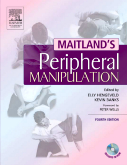|
|
|
| |
 |
|
|

|
 推薦指數:
推薦指數:





|
|
- 內容介紹
|
Maitland's Peripheral Manipulation, 4th Edition
By Elly Hengeveld, MSc, BPT, OMT, SVOMP and Kevin Banks, BA, MCSP, SRP
644 pages, 685 ills,
Trim size 7 7/16 X 9 11/16 in,
Copyright 2005
Description
The thoroughly revised edition of this classic text describes the art of manipulative physiotherapy as delineated by G.D. Maitland – a unique approach based on procedures for thorough assessment and reassessment of patients. The 4th edition has been extensively revised by two respected authorities, presenting an integrated contemporary and evidence-based model of manipulative physiotherapy. Updated and expanded coverage throughout reflects advances in knowledge and the role of manipulative physiotherapy within contemporary clinical practice. New highlights include an improved layout, new photographs, and an accompanying CD-ROM that includes video clips of all relevant examination and treatment techniques.
Key Features
The Maitland Concept of manipulative physiotherapy uses unique assessment processes that serve as the basis for clinical practice.
Evidence-based material is accessible and relevant to clinical practice.
Boxes are highlighted in color to reinforce key concepts.
Discussion of clinical pathology includes clear explanations of treatments.
Assessment and treatment of patients is clearly explained.
Case studies encourage critical thinking and application of processes.
Chapter summaries are presented at the beginning of each chapter, including a glossary of terms.
The role of self-management strategies is described within the context of overall management, addressing principles of compliance enhancement and aspects of behavioural change.
New to this Edition
New two-colour format adds visual interest and clarifies important concepts, featuring an enhanced layout with user-friendly bullet points and summaries.
All chapters have been expanded and enhanced to reflect evidence-based information and current practice.
Each technique for examination and treatment is accompanied by a video sequence on the accompanying CD-ROM.
The chapter on Communication and the Therapeutic Relationship addresses the essence of communication as a tool for gathering information as well as shaping therapeutic relationships.
Techniques are now illustrated with high-quality photographs instead of line drawings, making techniques remarkably clear and easy to follow.
A new chapter on Contemporary Perspectives in Physiotherapy Practice integrates the Maitland Concept into contemporary perspectives of physiotherapy, including clinical reasoning, biopsychosocial paradigms, and qualitative and quantitative research.
An additional appendix examines self-management strategies for patients.
Updated material throughout includes reference to International Classification of Functioning, Disabilities and Health (ICF), neurophysiological pain-mechanisms, biopsychosocial paradigms, current definitions and descriptions of physiotherapy practice.
Table of Contents
Preface to the first edition Preface to the fourth edition Companion Texts 1. The Maitland Concept - An Introduction 2. Mobilisation and Manipulation-Definitions, mechanisms of action and evidence-base 3. Communication and the Therapeutic Relationship 4. Contemporary Perspectives in Physiotherapy Practice 5. Principles of Assessment 6. Principles of Examination 7. Principles and Method of Mobilisation/Manipulation Techniques 8. Principles of Selection and Progression of Mobilisation /Manipulation techniques 9. Recording 10. Peripheral Neuromusculoskeletal Disorders 11. The Shoulder and Shoulder Girdle Complex 12. The Elbow Complex 13. The Wrist and Hand Complex 14. The Hip Region 15. The Knee Complex 16. The Ankle and Foot Complex 17. The Temperomandibular Joints,Larynx and Hyoid[The Craniomandibular Complex] Appendix 1: Movement Diagram Theory and Compiling a Movement Diagram Appendix 2: Self-management Strategies: Compliance and Behavioural Change Index
|
|
|

